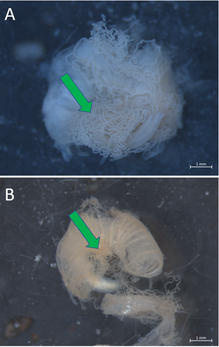|
When you see a honey bee buzzing around, or while you spread honey on your toast, have you ever wondered how old the honey bees that are visiting flowers or making honey are? The answer is: it depends. Worker honey bees assume different jobs in their life, and that role changes with age. Young workers take care of the colony, nursing and feeding the larvae. Later they become guards, protecting the hive. When the worker bee is even older, they take on the job of exploring the outdoors and foraging nectar and pollen for the colony. So, a bee pollinating a flower is probably older than the bee that made your honey.  Figure 1. Caged bees with lower lifespan produce less honey. “Median lifespan of caged bees, either mean observed or model estimated per year vs mean honey” (Nearman & vanEngelsdorp 2022). Figure 1. Caged bees with lower lifespan produce less honey. “Median lifespan of caged bees, either mean observed or model estimated per year vs mean honey” (Nearman & vanEngelsdorp 2022). However, these roles can switch depending on the needs of the colony. In spring, when colony population is growing, if there are too few bees at the age of foraging, younger bees will advance to this role faster. The same happens if there are too few young bees, older bees will take on the role of nursing. These shifts in age and numbers can be related to the health and mortality of the whole colony. Detecting shifts in age in the colonies can help predict the overall health of the colony. But how can we use these shifts to understand the lifespan of a colony? In his exit seminar, the UMD Entomology alum Dr. Anthony Nearman talked about his Ph.D. research in the vanEngelsdorp Bee Lab investigating mortality and colony lifespan prediction tools. Anthony performed laboratory caged studies to first look at how the bees react to different supplements of water and resources. He showed that bees that have access to water have a longer lifespan. To investigate what other variables apart from water availability could drive colony mortality, Anthony modelled populations using BEEHAVE, an internationally used modeling tool that simulates how colonies would react to different stressors. The models predicted that colonies with lower average bee life spans have lower success, producing less honey (Nearman & vanEngelsdorp 2022). So, the longer the bees live, the more a colony can thrive. But how can we tell how old the bees in the colony are? On the outside, worker bees look really similar, so it would be hard to say just by looking at them. But are worker bees all the same on the inside? Anthony further investigated if worker bee behavior and internal anatomy can clue us in on their age.  Figure 2. Older honey bees have more and clearer Malpighian tubules. Malpighian tubules in honey bees age 30 (A) and 3 days (B). Figure 2. Older honey bees have more and clearer Malpighian tubules. Malpighian tubules in honey bees age 30 (A) and 3 days (B). Previous work in the lab showed that some traits in a bee’s anatomy could be age-dependent (vanEngelsdorp et al 2017). But can any of these traits measure the age demography and predict bee colony mortality? To answer this, Anthony observed traits mostly in the abdomen of bees from different ages, reared in cages and in colonies across seasons. To measure age, traits should change in prevalence over time, show large enough differences to be detected, while being consistent across rearing environments and seasons. He found four traits that met all the criteria: hypopharyngeal gland development, Malpighian tubule quantity, rectum color, and rectum size. For instance, older bees have many more Malpighian tubules than younger bees. This demonstrates that while the bees may visually look the same to us, their internal anatomy and physiology could be different. Can these individual age-dependent changes be extrapolated to the lifespan of a whole colony when faced with risk factors such as Varroa mite infestation? Anthony compared the physiology of bees from healthy colonies and colonies infested by mites, which might perish over the winter season. He sampled those colonies in September for three years and found that if a colony has too many older bees before the winter, there is a lower chance of survival. This research presents potential methods to estimate the age of honey bees and sets the groundwork for studies in controlled environments. Author: Taís Ribeiro is a PhD student in the EspíndoLab working on the ecology and evolution of South American oil-collecting bees from the genus Chalepogenus.
References VanEngelsdorp, D., Traynor, K. S., Andree, M., Lichtenberg, E. M., Chen, Y., Saegerman, C., & Cox-Foster, D. L. (2017). Colony Collapse Disorder (CCD) and bee age impact honey bee pathophysiology. PLoS One, 12(7), e0179535. https://doi.org/10.1371/journal.pone.0179535 Nearman, A., & VanEngelsdorp, D. (2022). Water provisioning increases caged worker bee lifespan and caged worker bees are living half as long as observed 50 years ago. Scientific Reports, 12(1), 18660. https://doi.org/10.1038/s41598-022-21401- Comments are closed.
|
Categories
All
Archives
June 2024
|
Department of Entomology
University of Maryland
4112 Plant Sciences Building
College Park, MD 20742-4454
USA
Telephone: 301.405.3911
Fax: 301.314.9290
University of Maryland
4112 Plant Sciences Building
College Park, MD 20742-4454
USA
Telephone: 301.405.3911
Fax: 301.314.9290

 RSS Feed
RSS Feed




